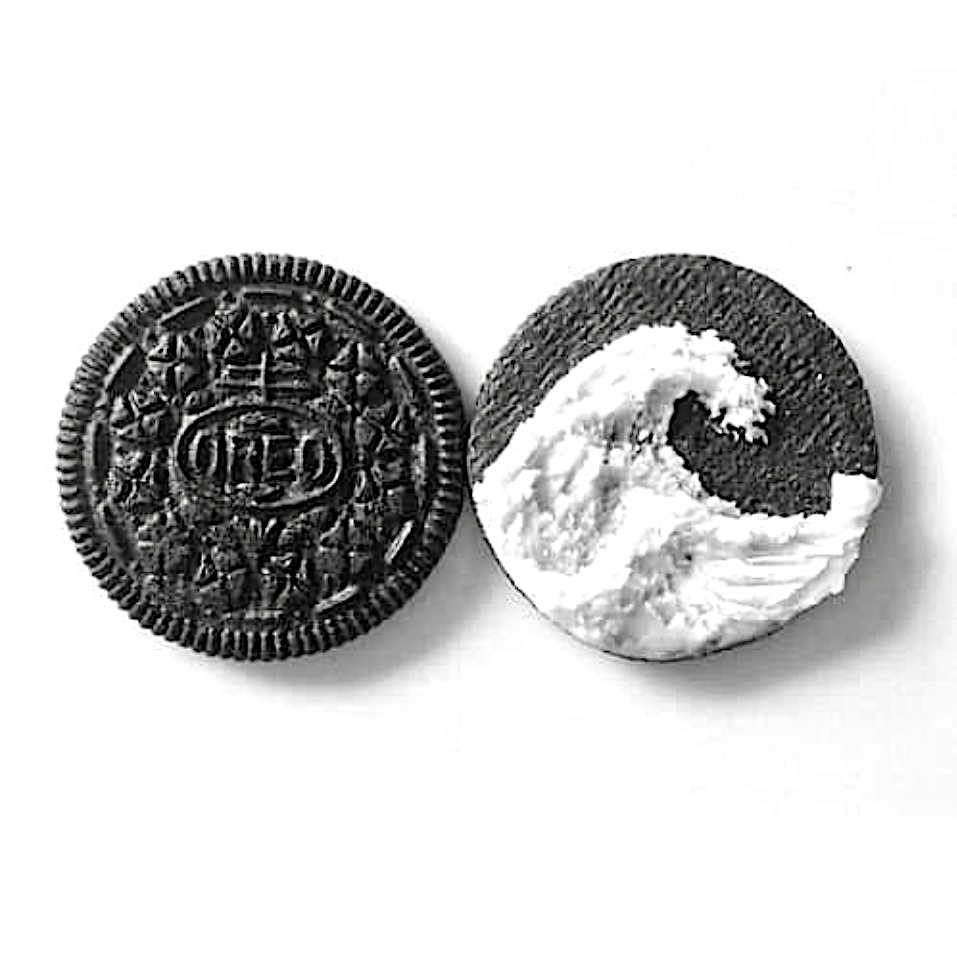Some things in life you just know are immortal, like death, taxes, and the fact that somewhere right now, someone is either biting into an Oreo or buying a postcard of The Great Wave off Kanagawa.
At first glance, Oreo cookies and Hokusai’s iconic woodblock print seem like they belong in entirely different galaxies. One is an American snack engineered for mass consumption, precision-stacked into plastic trays. The other is a revered piece of Japanese art that survived earthquakes, tsunamis, and TikTok trends, now hanging with solemn pride in museums around the world. And yet, somehow, these two have become unlikely spiritual cousins.
Both are masters of global branding, long before global branding was even a thing. The Great Wave didn’t need Google Ads, a marketing team, or an overpriced Super Bowl commercial to become one of the most recognizable images in human history. Oreos didn’t need a Michelin star or a viral TikTok dance challenge to become a universal edible currency (seriously, you could probably barter Oreos for survival gear in certain parts of the world—it would work faster than Bitcoin).
What’s fascinating is how both have evolved while keeping their core soul intact, a quiet kind of Kaizen. Hokusai spent a lifetime mastering his craft—producing over 30,000 pieces, pushing the traditional ukiyo-e style beyond what anyone thought possible. The Great Wave wasn’t a one-off stroke of genius; it was the result of decades of experiments, failures, refinements, and relentless curiosity.
Meanwhile, Oreo has mutated into a galaxy of strange and wonderful variations: double-stuffed, mint, thin, peanut butter, pumpkin spice, birthday cake, Swedish Fish, wasabi—because somewhere in a Nabisco boardroom, someone said “Why not?” and nobody stopped them.
Look closer, and you’ll also see the beauty of imperfection shining through, another distinctly Japanese value: Wabi-Sabi. Open a pack of Oreos, and you’ll notice the crème filling is rarely centered and the cookie edges are often a little imperfect. It’s gloriously inconsistent in a way that feels handmade, not manufactured. Similarly, The Great Wavecaptures not a sterile, composed moment but the raw, chaotic crash just before destruction—a moment of pure energy caught mid-roar.
Perfection is boring; it’s the wobble that makes it sing.
Neither Oreo nor Hokusai tried to be anything else but themselves. Oreos didn’t suddenly pivot into gluten-free keto protein bars (until recently, and even then, grudgingly). Hokusai didn’t paint portraits of European nobles or try to be Japan’s answer to the Mona Lisa. Each followed Oubaitori, growing into their own nature without copying anyone else’s path.
This stubborn authenticity is why they lasted. It’s why The Great Wave feels just as alive in a Tokyo gallery or on a New York tote bag. It’s why the Oreo still sparks small moments of joy in airports, vending machines, and emergency midnight snacks worldwide.
If you bite into an Oreo or stare into the waves of Hokusai’s vision, something happens—you stop thinking for a second. You are just there, caught in a tiny, perfect, suspended moment of flow. That’s Mushin—pure mindlessness in the best possible sense. Marketing so good it feels like breathing.
(Author’s note: No, Nabisco didn’t sponsor this article. But if they want to, my inbox is open wider than a double-stuffed Oreo.)
Author’s note
Yes, I’m comparing Oreos and Hokusai today. No, I haven’t been eating questionable mushrooms, yet. At the end of the day, Oreos and The Great Wave aren’t just products; they’re living lessons in how to quietly take over the world. They didn’t need a ten-point brand strategy, an algorithm-driven authenticity playbook, or a chase-the-next-trend frenzy. They simply stood still, got good at being themselves, and let the world come to them. And no, Nabisco didn’t sponsor this article. But if they want to, my inbox is open wider than a double-stuffed Oreo.
So if you ever find yourself overcomplicating your next big idea, take a second, think about a cookie, think about a wave, and if you do, try not to get caught in the undertow. Keep it simple, keep it imperfect, stay true. Ride the wave, dunk the cookie, repeat.
クッキーと津波:世界征服のレッスン
バリー・アシュワース
人生には不滅のものがある。死、税金、そして今この瞬間どこかで誰かがオレオをかじっているか、神奈川沖浪裏のポストカードを買っているという事実だ。
一見すると、オレオクッキーと北斎の代表作である浮世絵は、まったく別の銀河系に存在するように見える。ひとつは大量消費向けに設計され、プラスチックのトレイにきっちり詰められたアメリカのおやつ。もうひとつは、地震や津波、そしてTikTokブームすら乗り越えて、今では世界中の美術館に厳かに展示される日本の芸術作品。しかし、どういうわけかこの二つは、意外にも精神的な「いとこ同士」になっている。
どちらもグローバルブランディングの達人——それも、グローバルブランディングという言葉がまだ存在しない時代から。神奈川沖浪裏は、Google広告も、マーケティングチームも、高額なスーパーボウルCMも必要とせず、人類史上最も認識されているイメージのひとつになった。オレオはミシュランの星やバズったTikTokダンスもなしに、世界共通の「食べられる通貨」になった(真面目な話、オレオでサバイバル用品と物々交換できる国もある。ビットコインより早いかも)。
興味深いのは、どちらも時代に合わせて進化しつつ、その「核となる魂」は守り続けているということ。まさに静かなカイゼンだ。北斎は生涯をかけて自身の技を極め、3万点以上の作品を生み出し、浮世絵の可能性を誰もが想像しなかった領域まで押し広げた。神奈川沖浪裏は天才のひらめき一発ではなく、何十年もの試行錯誤、失敗、改善、そして執念の探究の末に生まれた結晶である。
一方で、オレオは奇想天外な進化を遂げている。ダブルクリーム、ミント、薄型、ピーナッツバター、パンプキンスパイス、バースデーケーキ、スウェディッシュフィッシュ、わさび味——ナビスコの会議室で誰かが「やってみよう」と言い、誰も止めなかったのだ。
よく見ると、そこには「不完全さの美しさ」も見えてくる。これはまさに日本的価値観、侘び寂び。オレオを開けてみれば、クリームはたいてい真ん中に収まっておらず、クッキーの縁も少し不揃い。工業製品なのにどこか手作り感があって、むしろ愛おしい。そして神奈川沖浪裏もまた、整った構図ではなく、破壊の直前、カオスが渦巻く一瞬の爆発的なエネルギーをとらえている。
完璧なんて退屈だ。少しの「ぐらつき」こそが魂を響かせる。
オレオも北斎も、「誰かになろう」とはしなかった。オレオは(最近までは)グルテンフリーのケトプロテインバーに変身したりしなかったし、北斎も西洋の貴族の肖像を描いて「日本のモナリザ」になろうとしなかった。それぞれが「桜梅桃李(おうばいとうり)」の精神で、誰とも比べず、自分の道を貫いた。
この「頑固なまでの本物らしさ」こそが、彼らを時代を超えて生かし続けた理由だ。だからこそ、神奈川沖浪裏は東京のギャラリーでもニューヨークのトートバッグでも同じように生きているし、オレオは世界中の空港、自販機、そして深夜の非常食として、小さな喜びを提供してくれる。
オレオをひとかじりする時、あるいは北斎の波に目を奪われた瞬間、ふと「思考」が止まる。ただ、そこに在る。その一瞬の静止した完璧な「流れ」に包まれる。それが「無心」——最良のかたちでの「何も考えない心」。マーケティングでありながら、まるで呼吸のように自然。
(著者注:いいえ、この記事はナビスコの提供ではありません。でももしスポンサーしてくれるなら、私のメールはダブルクリームのオレオより広く開いてます。)
著者メモ
そうです、今日はオレオと北斎を比べてます。そしていいえ、怪しいキノコはまだ食べてません。結局のところ、オレオと神奈川沖浪裏はただの製品じゃなく、世界を静かに制覇する方法を教えてくれる生きた教材なんです。10か条のブランディング戦略も、AI駆動の「本物感」プレイブックも、流行追いのドタバタも要らなかった。彼らはただ立ち止まり、自分らしさを磨き、世界がやって来るのを待っていただけ。
だからこそ、次のアイデアをこねくり回しすぎていると感じたら、ちょっと立ち止まってみてください。クッキーのことを考える。波のことを考える。そして、できればそのまま波にさらわれないように。
シンプルに。不完全なままに。自分に忠実に。波に乗り、クッキーを浸し、そしてもう一度。


Leave a Reply